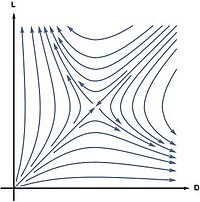User:Sprlzrd/sandbox
Chiral amplification[edit]

In 1953, Charles Frank proposed a model to demonstrate that homochirality is a consequence of autocatalysis[1]. In his model the L and D enantiomers of a chiral molecule are autocatalytically produced from an achiral molecule A
- A + L → 2L, A + D → 2D
while suppressing each other through a reaction that he called mutual antagonism
- L + D → ∅.
In this model the racemic state is unstable in the sense that the slightest enantiomeric excess will be amplified to a completely homochiral state. This can be shown by computing the reaction rates from the law of mass action:
where is the rate constant for the autocatalytic reactions, is the rate constant for mutual antagonism reaction, and the concentration of A is kept constant for simplicity. By defining the enantiomeric excess as
we can compute the rate of change of enatiomeric excess using chain rule from the rate of change of the concentrations of enantiomeres L and D.
Linear stability analysis of this equation shows that the racemic state is unstable. Starting from almost everywhere in the concentration space, the system evolves to a homochiral state.
It is generally understood that autocatalysis alone does not yield to homochirality, and the presence of the mutually antagonistic relationship between the two enantiomers is necessary for the instability of the racemic mixture. However, recent studies show that homochirality could be achieved from autocatalysis in the absence of the mutually antagonistic relationship, but the underlying mechanism for symmetry-breaking is different [2] [3].
Experiments[edit]
- ^ Frank, F.C. (1953). "On spontaneous asymmetric synthesis". Biochimica et biophysica acta. 11. Elsevier: 459--463. doi:10.1016/0006-3002(53)90082-1.
- ^ Jafarpour, Farshid; Biancalani, Tommaso; Goldenfeld, Nigel (2017). "Noise-induced symmetry breaking far from equilibrium and the emergence of biological homochirality". Physical Review E. 95. APS: 032407. doi:10.1103/PhysRevE.95.032407.
- ^ Jafarpour, Farshid; Biancalani, Tommaso; Goldenfeld, Nigel (2015). "Noise-induced mechanism for biological homochirality of early life self-replicators". Physical Review Letters. 115. APS: 158101. doi:10.1103/PhysRevLett.115.158101.


![{\displaystyle {\begin{aligned}{\frac {d[L]}{dt}}&=k_{a}[L]-k_{d}[L][D]\\{\frac {d[D]}{dt}}&=k_{a}[D]-k_{d}[L][D],\end{aligned}}}](https://wikimedia.org/api/rest_v1/media/math/render/svg/01bf21b640abd3eebc659196218b1e097af14f18)



![{\displaystyle \Phi ={\frac {[D]-[L]}{[D]+[L]}},}](https://wikimedia.org/api/rest_v1/media/math/render/svg/d16033e26fb60c26fb7d28267155c5b2dd388981)
![{\displaystyle {\frac {d\Phi }{dt}}=\left({\frac {2k_{d}[L][D]}{[D]+[L]}}\right)\Phi .}](https://wikimedia.org/api/rest_v1/media/math/render/svg/91a46372e8c1a492be7b0fb97248766f505ff1d3)
